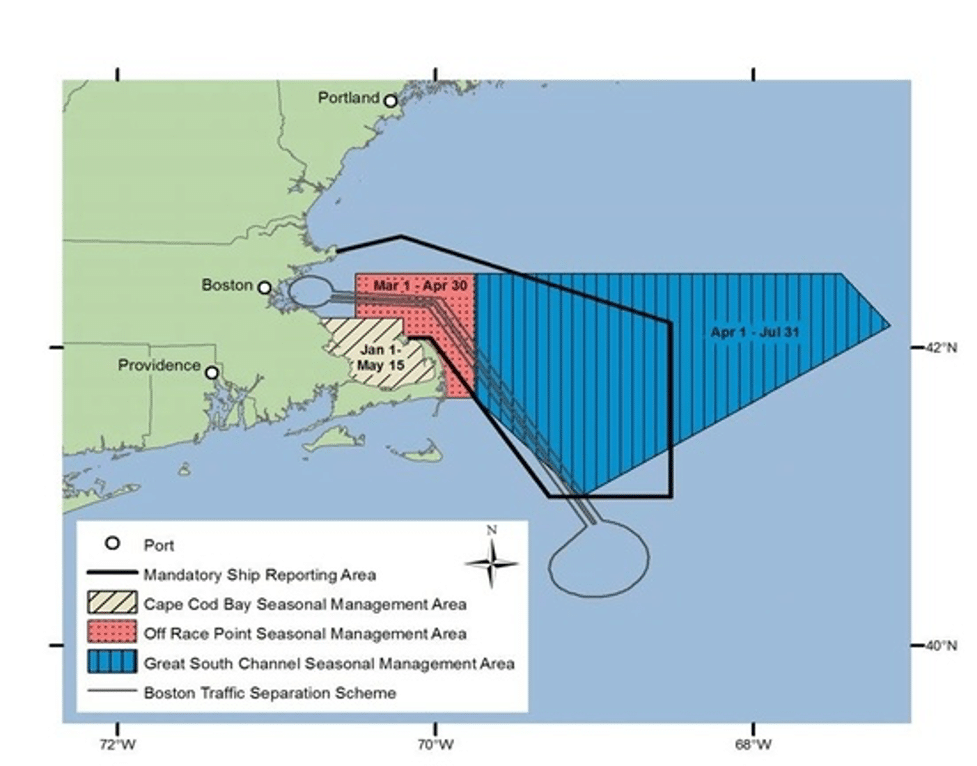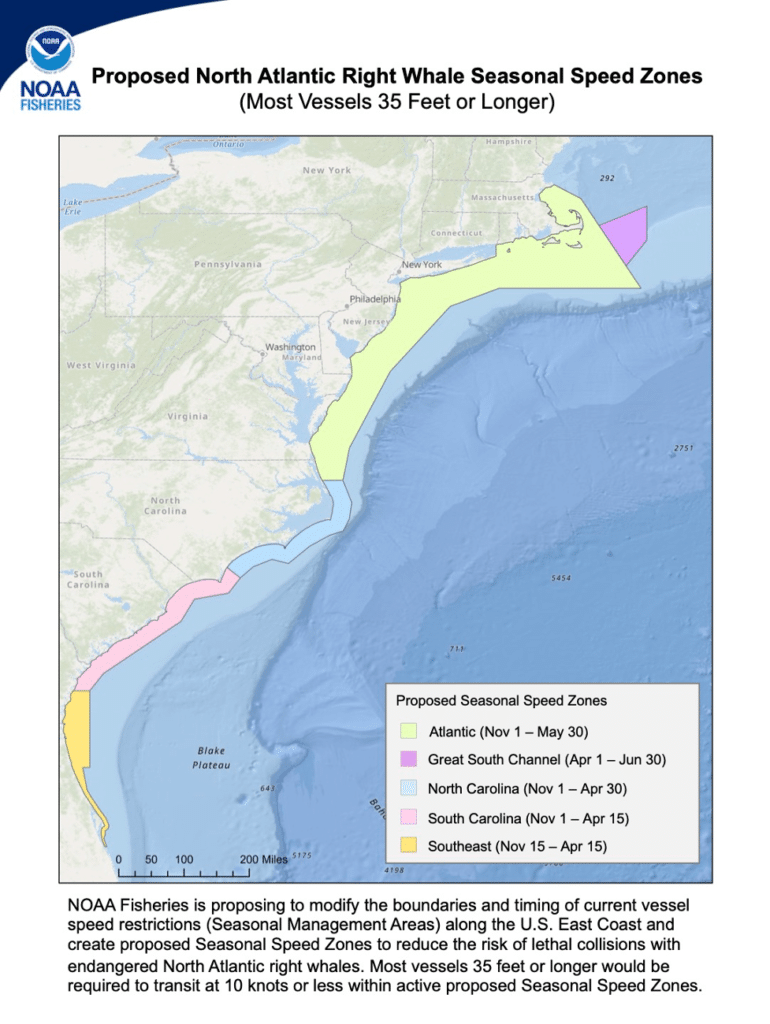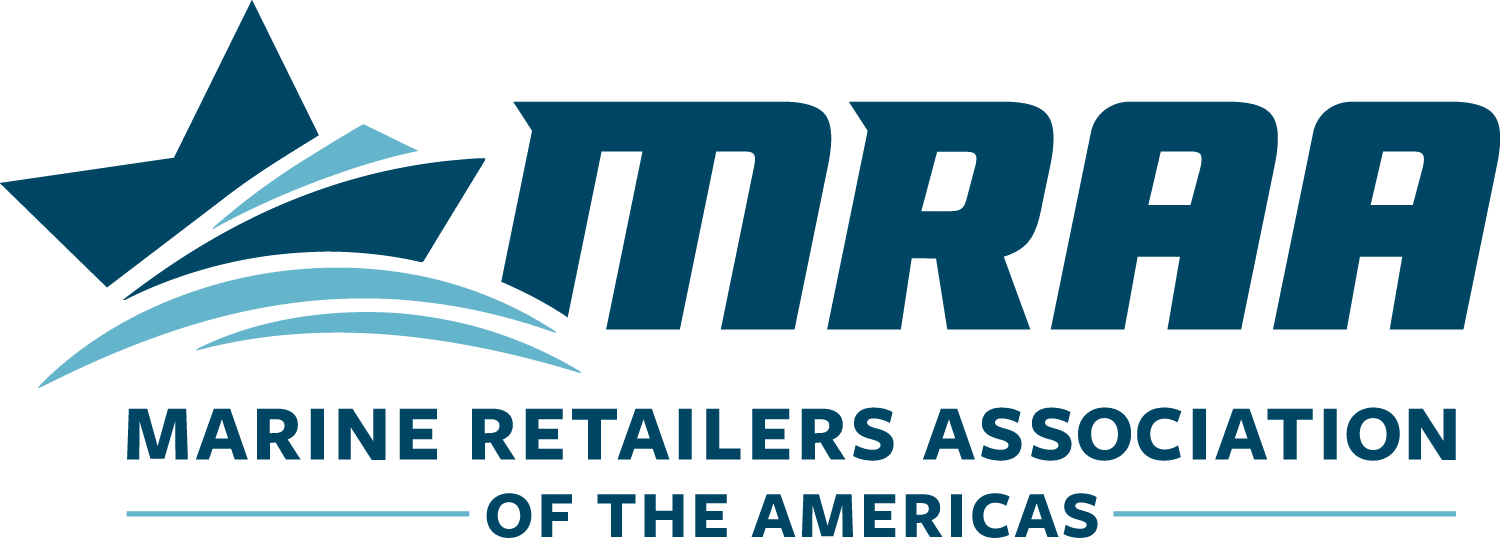August 1, the National Marine Fisheries Service (NMFS) released a proposed rule to put in place additional vessel speed regulations to further protect North Atlantic right whales. The proposed rule would change the spatial and temporal boundaries of the speed reduction zones and include most vessels greater than or equal to 35 feet and less than 65 feet — directly impacting recreational boaters. Let’s take a look at the current status of North Atlantic right whales, explore the nuances of the proposed rule, share insights from the recreational fishing and boating community and supply you with tools for action.
This proposed regulation will have one of the largest impacts on recreational boating in our lifetime on the Eastern Seaboard, and for that reason it is imperative every member of the boating and fishing community stand united.
History
North Atlantic right whales are charismatic megafauna with a long and storied history inextricably tied to our nation’s industrial revolution and efforts to revitalize the population. Due to a variety of factors, such as their slow pace, thick blubber and tendency to float after being harpooned, the North Atlantic right whale quickly became the preferred whale to harvest and by the 1850s, the United States had become the leading whaling country in the world, with the majority of the activity coming from ports in Nantucket and New Bedford, Massachusetts.[1] At the time, right whales provided critical resources such as whale oil, which was burned in lamps, used in candles, as lubricant, and more, baleen, and ambergris.[2] Due to the reliance on the North Atlantic right whale the stock was quickly depleted and in 1935 the League of Nations banned the hunting of all right whales.[3]
Current Status of North Atlantic Right Whales
Currently, the North Atlantic right whale population is estimated to contain fewer than 350 individuals and are listed as “endangered” under the Endangered Species Act (ESA) and as “protected” under the Marine Mammal Protection Act (MMPA).[4] The listing of North Atlantic right whales under the ESA and MMPA provide significant protections for the species and there is already a slew of efforts underway to help the species recover after years of commercial harvest that dates back to whaling in the 1800s.
Protective Measures
Due to their listing under the ESA, the National Oceanographic and Atmospheric Administration Fisheries Department (NOAA Fisheries) is responsible for developing and implementing a “recovery plan” to guide the conservation and survival of the North Atlantic right whale. This recovery plan currently lays out various conservation actions such as protecting habitat essential to the survival and recovery of right whales, to efforts that minimize the effect of vessel disturbance and more. In 2008 NOAA put in place a mandatory vessel speed rule that requires vessels longer than 65 feet to slow their speed in certain seasonal management areas to 10knots or less. For any folks not familiar with maritime terms, knots, abbreviated kts, is defined as one nautical mile per hour and is used to measure speed. One knot is equivalent to 1.15 miles per hour. Currently, the areas subject to this speed rule, because right whales are likely to be there, are called “Seasonal Management Areas” (SMAs) and are generally located around major seaports along the East Coast. NOAA enforces this regulation by monitoring Automated Information Systems (AIS), a required location tracker on most vessels larger than 65 feet. By reviewing this data NOAA can determine which vessels are not in compliance with the speed rule. However, this technology is used primarily by commercial mariners to relay their position to other vessels on the high-seas for safety and navigational purposes, and is seldom featured on recreational boats especially in the 35- to 65-foot size class.

According to NOAA’s Office of Protected Resources North Atlantic Right Whale Vessel Speed Rule Assessment from June of 2020, there is a high degree of compliance with the speed rule as in 2018-2019, the proportion of total vessel transit distance through active Seasonal Management Areas (SMA) at speeds less than 10 knots was at 81 percent. The vessels in question here are large vessels, over 65 feet, and are being tracked through AIS.
How Does the Proposed Rule Compare with the Old Rule?
NOAA’s proposed changes to the mandatory vessel speed rule will pull recreational boaters into the fold and severely hamper fishing and high-seas adventures. According to the NOAA’s Draft Environmental Assessment for Amendments to the North Atlantic Right Whale Vessel Strike Reduction Rule (Draft EA), the new regulations will be making three primary changes:
- Requiring most vessels greater than or equal to 35 feet in length and less than 65 feet in length to transit at 10 knots or less within active Seasonal Management Areas.
- Expanding SMA (now called Seasonal Speed Zone) boundaries and timing to better capture areas and times with elevated vessel strike risk.
- Implementing a new Dynamic Speed Zone (DSZ) framework to provide mandatory vessel speed reductions that are outside Seasonal Speed Zones.
The newly proposed regulations stand to drastically change recreational boating along the East Coast. For the first time ever, from Massachusetts to Florida, recreational class boats may be required to adhere to a speed limit. The map below outlines the newly proposed vessel speed boundaries. Northeast Ocean Data also created an interactive map.

While the map above outlines the newly proposed boundaries of the proposed regulations, it does not include additional zones that may be classified as a DSZ. A DSZ is put in place only after NOAA confirms that there are whales in a certain area and that there is more than a 50 percent chance the right whales remain in the area.
As currently drafted, these newly proposed regulations stand to dramatically impact recreational boating and fishing along the Eastern Seaboard. Whether you are a recreational angler, a yacht owner port-hopping along the coast, or a boater trying to get back ashore before weather conditions deteriorate, this rule will fundamentally impact every aspect of recreational boating for many months of the year.
What our Community is Doing
The MRAA has been working with a large coalition of boating and fishing groups to provide input to NOAA on the proposed rule. We, along with the American Sportfishing Association, Boat Owners Association of the United States, Bonefish and Tarpon Trust, Center for Sportfishing Policy, Coastal Conservation Association, Congressional Sportsmen’s Foundation, Guy Harvey Ocean Foundation, International Game Fish Association, National Marine Manufacturers Association, Recreational Fishing Alliance and Theodore Roosevelt Conservation Partnership first engaged on the rule by sending a letter to request that NOAA extend the comment period. It was granted, extending the comment period to October 31. Click here to view our extension request.
The recreational fishing and boating community prides ourselves on conservation and have a long track record of not only directly supporting conservation through excise taxes paid into the Sport Fish Restoration and Boating Trust Fund (SFRBTF) but through our advocacy efforts as well. In recent years the recreational fishing and boating community has been able to bridge partisan divide on Capitol Hill to move forward important conservation priorities like Americas Conservation Enhancement Act and reauthorizing the SFRBTF. However, our community also has a responsibility to intervene when decisions do not reflect proper natural resource management, to ensure an outcome that balances achieving conservation goals with practicality. For that reason, a coalition has been working hard to develop arguments and reasons why NOAA should pause and re-evaluate the rule. The coalition submitted comment to NOAA Monday, Oct. 3, which can be viewed here. Among the recreational fishing and boating community’s many concerns with the proposed rule, most notable are:
- An analysis of National Marine Fisheries Service (NMFS) data found approximately 5.1 million recreational fishing trips were taken in this region by vessels 35—65 feet in length since 2008. Assuming all five right whale strikes during that time were from recreational vessels, and that all these vessels were on fishing trips, the chance of a 35- to 65-foot recreational vessel striking a right whale during an offshore fishing trip is at most 0.000098%, or less than one-in-a-million. Attempting to predict risk on a one-in-a-million chance of a vessel strike is simply not an effective management strategy and highlights the futility of expanding the Seasonal Speed Zones (SSZs) to address such a small possibility of vessel strike interactions.
- NMFS is using unrepresentative whale density values in their risk modelling, thereby creating a significant bias that may overestimate risk to whales from small vessel strikes. NMFS’ own technical memo states that, “the high densities predicted along the mid-Atlantic may not be realistic.”
- The model assumes 10-meter draft depth criteria when calculating vessel strike risk. However, recreational vessels in this size class rarely have a static draft that exceeds 2 meters. This also creates bias that may overestimate risk to whales from small vessel strikes.
- NMFS underestimates the number of recreational vessels that will be impacted by the proposed rule at 9,200 vessels. However, based on 2021 vessel registration data analyzed by Southwick Associates, there were more than 63,000 registered recreational saltwater vessels measuring 35—65 feet in states across the proposed SSZs.
- NMFS estimates the positive economic output from whale watching in the northeast at $95.1 million. In contrast, NMFS estimates $46.2 million in negative impacts for all vessel size classes and regions combined. It is difficult to understand how the economic benefits of whale watching operations in the northeast exceeds the proposed rule’s economic harm to all recreational vessels.
- Enforcement of the proposed rule using Automatic Identification Systems (AIS) would be impractical and could lead to significant human safety risk. AIS is mandatory for certain vessels over 65 feet to improve the navigational safety of the vessel and other vessels operating in the area. AIS is not required on recreational vessels 35—65 feet although many boat owners voluntarily carry and operate AIS for the added safety-at-sea benefits. It is a very real concern that operators of boats less than 65 feet may decide to turn off their AIS systems in fear of triggering a speed restriction enforcement action. This would have the unfortunate consequence of reducing navigational safety, boater safety and hampering efforts during search-and-rescue operations.
- Vessel speed is a significant safety feature on a recreational boat. Most recreational boats lack high displacement hull design that often provides ocean-going and commercial vessel stability and the ability to operate safely in significant sea states. The 10-knot speed limit would force recreational boaters to operate in conditions that would compromise safety of the passengers and vessel.
In addition to this well-researched and reasoned comment letter, our community is still working to provide input to NOAA. Part of that input is getting MRAA members to submit comments. We encourage you to share feedback through the Boating United action alert, just click here.
[4] https://www.fisheries.noaa.gov/species/north-atlantic-right-whale#overview
